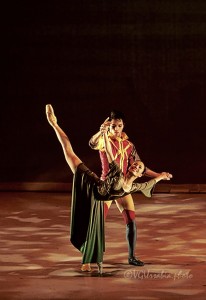A refreshing season-ender for Ballet Philippines came in the guise of William Shakespeare’s “A Midsummer Night’s Dream.”
The ballet, which has been a staple in many international ballet companies, underwent a transformation in the hands of guest choreographer Carlo Pacis, Hong Kong-based dancer, teacher and choreographer.
In the past 12 years Pacis danced with the Hong Kong Ballet as senior soloist. A first-class honors graduate of Hong Kong Academy for Performing Arts, he also received in 2002 the Hong Kong Dance Award.
Traditionally, the ballet calls for a “vedy” English production design depicting fairies and gnomes in mossy, misty woods, foggy lighting and ethereal wisps of wings, chiffon and glittering fairy dust. Pacis, however, debunks this look, favoring a contemporary clean line, verging on a quirky techno flavor.
The set design by Ricardo Cruz clearly relies on modern technology to pull this through: bamboo-like horizontal pillars running the breadth of the dancing space; flora and foliage executed in Oriental brushstrokes; supported by digital film effects by Digibox’s Laz’Andre Cawagas projected on the proscenium and on the set levels; enhanced by John Batalla’s clean and crisp light design.
The costumes, with all sorts of cross-references from an Avatar-like Oberon, Star Wars-inspired get-ups for Theseus and Hippolyta, various Japanese-inspired peasant and warrior togs, and then Titania’s Cruella de Ville brush-up hairdo, may or may not have helped the look the production is going for.
A new role
More importantly was the choreographic work produced by Pacis, which exhibited a mastery of his material, enabling him to freely reinterpret a classic that had passed through the hands of masters like Frederick Ashton and George Balanchine before him.
Like Balanchine, Pacis extended the original 1826 score of Felix Mendelssohn with the addition of other pieces by the composer, weaving additional scenes and characters and removing some found in the original. From his choreographer’s notes, he says:
“It was paramount to pare the story down to the essentials, so I did away with some of the characters… and highlighted the four love stories within the story… I also decided to create a new role that does not exist in the play: a dancing role for Love-in-Idleness, the flower whose potion wreaks havoc on the lives of the protagonists.”
Adding the tale of Pyramus and Thisbe in the wedding celebration of Act 2, for example, harkens back to a Shakespearean tendency to sometimes add a play-within-a-play; and thematically Pyramus and Thisbe is a well-informed literary choice.
Historically, staging Greek myths and tales in royal celebrations, say, in the court of Louis XIV, was the entertainment of choice. Pacis seems to know from which wellspring of liberal arts to draw from.
Pacis’ choreographic language is vast, which makes his telling of the narrative rife with expression and excitement. Although the steps and nuances have already been observed in other contemporary neoclassic works, it is how he combines these to express his way of pushing the narrative along that makes it his own.
Aid from dancers
Much aid comes from dancers such as Cyril Fallar, who, as Puck, drives the ballet to its fullness with his extraordinary strength, technique and agility. With each performance, Fallar never ceases to surprise. More and more, he controls the colorations of his performance with his phrasing, sometimes holding off the unfurling of a développé to the last beat, or sustaining a tours en l’air or grande jete in midair.
As Puck, he flexes, contracts and releases his body, short of contortion when up to his impish tricks, and with a sort of grace which is termed as sprezzatura, loosely translated as “something difficult but done with apparent ease.”
As the royals, Richardson Yadao and Katherine Trofeo do not disappoint in their elegant characterizations. Trofeo is in her element, save for the curious headdress and the shoulder fluff that cuts her petite dancing figure.
Of the four lovers, Earl John Arisola is a standout. He is, indeed, the soloist to watch out for. This is not to say the other three do not perform well, because they do.
Arisola is perhaps one of those who possess the elusive “it factor.” Already notable in his recent supporting role in “Rama Hari,” Arisola has a kind of gestating stage presence, as he is blessed with height, physique and dance prowess in obvious development.
In the role of Hippolyta is Rita Winder, a Namcya awardee, who, like Arisola, is starting to exhibit star quality. Her expansive and expressive movement belies a growing confidence of technique and ease in the performance space.
Carissa Adea
Carissa Adea has always exhibited a flair for acting, aside from her unmistakably strong dance technique. However, in scenes that demand her to act, it would do her well to restrain herself from giving in to daytime-television acting techniques like stomping of feet and caricature frowning, which steal away from the silent eloquence of her dance mastery.
Adea is undoubtedly a beautiful expressive dancer in control of her technique, until theatrics gets the better of her.
There, too, is a pleasing display of strength and unison in the corps. The Godfather of Dance, Eddie Elejar, proudly commented that many of the male corps members were initially trained by the late Tony Fabella and Luther Perez, both known to be Elejar’s partners and collaborators since forever.
The pride in his tone was unmistakable, and in my gut surged a warm sentimental feeling of gratitude to them who had devoted more than a lifetime of nurturing young bodies to give performances such as these.
It has been said many times that a choreographer is only as good as his instrument, the dancer. In this, the quote proves more than true, for if the choreographer knows how to play his instrument well, then so much the better for a happy audience.
Carlo Pacis’ first full-length “A Midsummer Night’s Dream” signals the success of his initiation that is met with great expectations, hopefully in the near future.